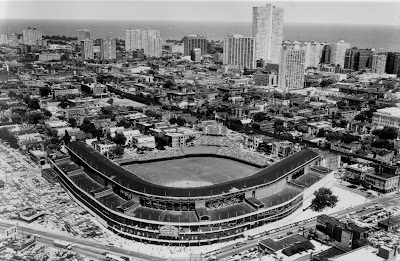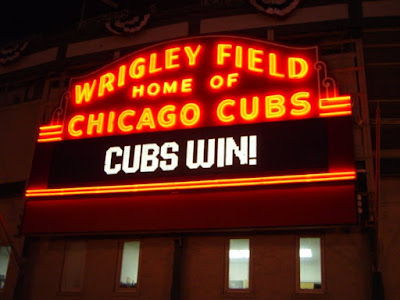The Chicago Cubs franchise, the only charter National League team still playing in its original city, has been the primary tenants of Wrigley Field since 1916. Originally named Weeghman Park, the field was built in 1914 for Charles Weeghman and his Chicago Whales of the Federal League, an unsuccessful contender with the established National and American Leagues. The first major league game at the park occurred on April 23, 1914; the Federals beat Kansas City.
As part of negotiations between the three leagues in 1915, Charles Weeghman was offered an option to buy the Cubs.
. In order to do so, he recruited investors that included William Wrigley, the owner of the Wrigley chewing gum company. Weeghman raised the necessary money and the first National League game at Weeghman Park was held on April 20, 1916; the Cubs beat the Cincinnati Reds. In 1918, Weeghman sold his interest in the team to Wrigley and the field became known as Cubs Park in 1920. The ballpark was officially renamed for William Wrigley, Jr. in 1926.
Wrigley Field is noted for several interesting innovations in baseball history. Weeghman, in 1916, originated the custom of permitting fans to keep balls fouled into the stands, now a universal practice. He also placed refreshment booths behind the stands, reducing the number of vendors who plied the crowds, an innovation likewise extensively copied. The Wrigleys arranged to broadcast the club's games beginning in 1925; this was the first occasion on which the new medium was used for this purpose. Rather than causing people to stay home, the broadcasts drew fans from all over the Midwest and contributed vastly to the club's popularity.
Image/Text Ownership National Park Service: Information presented on this website, unless otherwise indicated , is considered in the public domain. It may may be distributed or copied as is permitted by the law.
Disclaimer U.S. Department of the Interior: Information presented on this website is considered public information and may be distributed or copied. Use of appropriate byline/photo/image credit is requested.
I, LBJacob09 the copyright holder of this work, hereby release it into the public domain. This applies worldwide.
In case this is not legally possible: I LBJacob09 grant anyone the right to use this work for any purpose, without any conditions, unless such conditions are required by law.
A well-known feature of Wrigley Field is the ivy-covered, brick outfield wall. The wall and the equally well-known bleachers behind it were constructed in 1937 when the outfield area was renovated. The ivy was planted by Bill Veeck during this renovation. The 27-foot high scoreboard was also added at this time, and remains manually-operated to this day. One of the traditions of the ballpark is the flying of a flag bearing a "W" or an "L" atop the scoreboard after a game. A white flag with a blue "W" indicates a victory; a blue flag with a white "L" denotes a loss. The Chicago Tribune Company has owned the Chicago Cubs since 1981. Many improvements have been made to Wrigley Field since that time, including the addition of lights for night games in 1988.
Wrigley Field was the stage for the Cubs capture of the National League championship in 1918, 1929, 1932, 1935, and 1938, but the Cubs lost the World Series in each of these years. The third game of the 1932 Series, with the Cubs facing the New York Yankees at Wrigley, gave baseball one of its most immortal and vigorously debated episodes. Babe Ruth came to bat in the fifth inning, with the score tied 4-4. After each of two strikes off Cubs pitcher Charley Root, Ruth held up a finger and appeared to point to the center-field corner. Ruth then proceeded to hit a home run over the fence in that corner. In 1938, Cubs fans at Wrigley witnessed Gabby Hartnett's renowned "Homer in the Gloamin" that clinched the league lead for the Cubs on the next to last day of the season. After 1938 the Cubs, except for a National League pennant in 1945, enjoyed no pronounced success until 1984, when they won the National League East title, which they again won in 1989.
Wrigley Field is not listed on the National Register, but it has been determined eligible for designation as a National Historic Landmark. The Secretary of the Interior determined it eligible on February 27, 1987.
Tags: Public Domain Clip Art and clip art or public domain and Chicago Cubs or Wrigley Field.















No comments:
Post a Comment